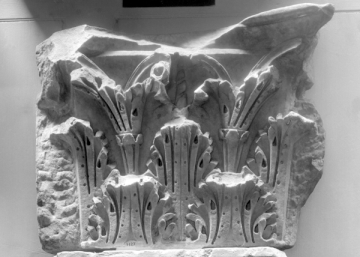Explore Collections


You are here:
CollectionsOnline
/
Fragment of a Roman Corinthian pilaster capital
Browse
Fragment of a Roman Corinthian pilaster capital
98-117 AD
Trajanic
Trajanic
Luna marble
Height: 41cm
Width: 56cm
Width (pilaster): 33cm
Thickness: 8cm
Width: 56cm
Width (pilaster): 33cm
Thickness: 8cm
Museum number: M1127
On display: Colonnade - north wall
All spaces are in No. 13 Lincoln's Inn Fields unless identified as in No. 12, Soane's first house.
For tours https://www.soane.org/your-visit
Curatorial note
This capital is carved out in high relief from a roughened surface, beneath a concave abacus which is nearly entirely broken away. The carving between the now missing volutes follows the normal pattern for a Corinthian capital.
The best parallels for the deep, dark, line cutting running vertically between the parts of the acanthus leaves and the regularly spaced drill points down the leaf centres are in the Trajanic period: the end of the first into the pre-Hadrianic second century AD1.
1 V. Scrinari, I Capitelli romani di Aquileia, Padua, 1952, no. 17, shows an example in the Museo di Aquileia, which from the photograph is a close parallel to this piece.
The best parallels for the deep, dark, line cutting running vertically between the parts of the acanthus leaves and the regularly spaced drill points down the leaf centres are in the Trajanic period: the end of the first into the pre-Hadrianic second century AD1.
1 V. Scrinari, I Capitelli romani di Aquileia, Padua, 1952, no. 17, shows an example in the Museo di Aquileia, which from the photograph is a close parallel to this piece.
This fragment may have been purchased by John Soane at the Robert Adam Sale (Christie's) 22 May 1818, Lot 90, A Corinthian pilaster capital and a Roman capital of an Ionic Column, £4.18.0.
Soane collections online is being continually updated. If you wish to find out more or if you have any further information about this object please contact us: worksofart@soane.org.uk


